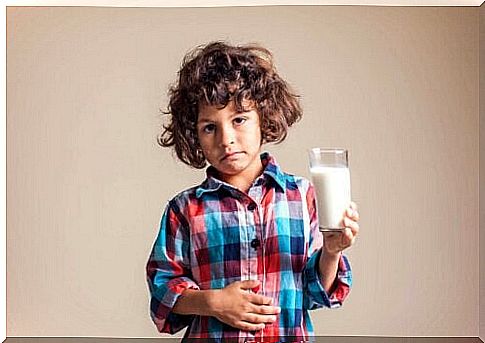The Allergy To Cow’s Milk Protein In Children

Did you know that the most common allergy in children is the allergy to cow’s milk protein ? In addition, it is one of the first allergies that children have, as children often drink cow’s milk before their first year of life. This is often before ingesting other potentially allergenic foods. This allows doctors to detect this allergy at an early age and start treatment as soon as possible to prevent future problems.
This allergy affects about 2% of all children and sometimes persists into adulthood. However, it is important to distinguish it from lactose intolerance. Why? Because there are many more types of foods that you should avoid. That is why it is important that you pay close attention in this situation, especially if your child eats at school.
Do you want to know how to recognize this allergy and what to do if an unexpected reaction occurs? Then continue reading this article, as we’ll tell you everything you need to know. We will also tell you what your child can eat and how to prepare his or her food to prevent an allergic reaction.

The diagnosis and symptoms of cow’s milk protein allergy
This allergy is an immune system response, so experts can detect it using IgE antibodies in the blood. There are two ways to investigate these: through a skin prick test and a blood test.
The skin prick test involves injecting the allergen under the skin and checking for red hives and itching over time. This method is the least invasive for children and is therefore the most used.
However, the blood test allows us to view the blood cells’ response to milk proteins.
Consider medical history, including your child’s family history and age when the potential allergy started and the time that has passed between taking the allergen and symptoms.
In general , you can recognize the allergy by red and itchy skin. In addition, you may also suffer from nausea, vomiting, diarrhea, abdominal pain and breathing pain.
Diet Treatment
Unlike lactose intolerance, dairy is not the only culprit in cow’s milk protein allergy. Veal and products derived from it, such as hamburgers, sausages, cannelloni, etc. contain it all.
In addition, there is a great similarity between milk proteins and goat and sheep meat. That’s why you should avoid these as well as all other sources of lactoglobulins and casein.
You can also find the allergen in sauces, ready meals, chocolate, cocoa, cereals, some breads and candies. This is because they are used as additives. You can even find it in soaps, body creams and medicines. Therefore, before you buy anything, read the label or ask the seller for advice. It is mandatory to indicate if this is in the product.
However, if the product only contains traces, it does not need to be declared. The amount is then too small to cause damage. If there are traces of cow’s milk protein, this usually means that there has been cross-contamination, because different products are then prepared on the same production line. If you are not sure whether a product is free of cow’s milk protein, it is better not to buy it.
Finally, remember to use different types of utensils when switching between preparing foods that do not contain cow’s milk protein and foods that do. It is even best to prepare these meals in separate rooms to avoid contact and cross-contamination. Remember to thoroughly clean all surfaces, pots and pans after use.
Food alternatives for children with cow’s milk protein allergy
As for dairy products, you can get extensive hydrolyzed formulas with the allergy removed. If not, you can use the following alternatives. However, keep in mind our recommendations:
- We recommend soy for children older than 12 months.
- Rice drink is not a good alternative because it contains large amounts of arsenic. This is a poisonous mineral that can be found in the earth.
- Other drinks, such as those made from oats or nuts, can be drunk without any problems. However, its nutritional value is not very similar to milk, as it hardly contains any protein. They are notable for their carbohydrate and fat content.
- Choose drinks that have no added sugars and, if possible, drinks that contain vitamin D and calcium.
As for meat, you can give your child chicken, rabbit, turkey and pork. We recommend that you add some citrus fruits or peppers to it to help your kids get more iron.
Learning to live with the allergy to cow’s milk protein
It is normal to have a lot of questions when you find out that your child is allergic to cow’s milk protein. We have already answered some of them for you. The problem, however, is that it’s common in staple foods — foods that play an important role in bone growth and the prevention of anemia.
However, there are foods available with the same benefits, such as broccoli, Brussels sprouts, almonds, beans, shellfish, fish and other meats.
So, when dealing with this allergy, you need to be very careful when buying food or eating out. You should read the labels carefully to avoid accidental ingestion or contact.
That is why you should always carry an adrenaline pen with you, so that the anaphylactic shock is reduced. This shock can be recognized by, among other things, difficulty breathing, dizziness, sweating and a fast heartbeat.









